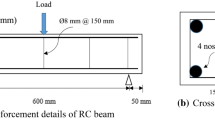A series of beam tests were performed to evaluate the ductility of reinforced concrete (RC) beams strengthened with carbon-fiber-reinforced polymer (CFRP) elements. A total of nine RC beams were produced and loaded up to failure in three-point bending under deflection control. In addition, the amount and shape of the CFRP elements (plates/sheets) were considered as the key test variables. Test results revealed that the strengthening with CFRP elements in the width direction was more effective than the strengthening across their height. The energy method used in an analysis showed that the energy ratio of the beams strengthened with CFRP plates were half or less than half of the energy ratio of the beams strengthened with CFRP sheets. In addition, the ductility of the beams decreased as the strengthening ratio of the CFRP elements increased.





Similar content being viewed by others
References
A. Gallab and A. W. Beeby, “Factors affecting the external prestressing stress in externally strengthened prestressed concrete beams,” J. of Cement and Concrete Composites, 27, No. 9, 945-957 (2005).
D. S. Yang, S. K. Park, and W. K. Neale, “Flexural behaviour of reinforced concrete beams strengthened with prestressed carbon composites,” Compos. Struct., 88, No. 4, 497-508 (2009).
K. B. Han, S. Hong, and S. K. Park, “Seismic performance evaluation of retrofitted bridge by isolation bearings,” Baltic Journal of Road and Bridge Engineering, 4, No. 3, 134-142 (2009).
T. Ibell, A. Darby, and S. Denton, “Research issues related to the appropriate use of FRP in concrete structures,” Construction and Building Materials, 23, No. 4, 1521-1528 (2009).
D. Y. Cho, S. K. Park, and S. Hong, “Bond-slip behavior of CFRP plate-concrete interface,” Mech. Compos. Mater., 47, No. 5, 529-538 (2011).
M. Venkat Rao, P. Mahajan, and R. K. Mittal, “Effect of architecture on the mechanical properties of carbon/carbon composites,” Composite Structures, 83, No. 2, 131-142 (2008).
H. Y. Kim, Y. H. Park, Y. J. You, and C. K. Moon, “Short-term durability test for GFRP rods under various environmental conditions,” Compos. Struct., 83, No. 1, 37-47 (2008).
M. Z. Jumaat and M. A. Alam, “Experimental and numerical analysis of end anchored steel plate and CFRP laminate flexurally strengthened R.C. beams,” Int. J. Phys. Sci., 5, No. 27, 132-144 (2010).
ACI 440R-96, State of the art report of fiber-reinforced plastic reinforcement for concrete structures, American Concrete Institute, Michigan. USA (1996).
M. Arduini, A. Di Tommaso, and A. Nanni, “Brittle failure in FRP plate and sheet bonded beams,” ACI Structural J., 94, No. 4, 363-370 (1997).
U. Meier, “Strengthening of structures using carbon fibre/epoxy composites,” Construction and Building Materials, 9, No. 6, 341-351 (1995).
K. B. Han, S. Hong, and S. K. Park, “RC slabs repaired and strengthened by an alumina/polymer mortar and prestressing strands in the tension zone: experimental investigation under static and fatigue loadings,” Mech. Compos. Mater., 48, No. 5, 587-602 (2012).
S. Matthys and L. Taerwe, “Deflection and cracking behavior of RC beams strengthened in flexure,” ACI SP264-06, 264, 95-110 (2009).
N. F. Grace, A.K. Soliman, G. Abdel-Sayed, and K. R. Saleh, “Behavior and ductility of simple and continuous FRP reinforced beams,” J. Compos. Construct., 2, No. 4, 186-194 (1998).
R. Hamid and H. Allan, “Concrete beams strengthened with externally bonded FRP plates,” J. Compos. Construct., 5, No. 1, 44-56 (2001).
Acknowledgement
This research was supported by the Basic Science Research Program through the National Research Foundation of Korea (NRF) funded by the Ministry of Education (2013R1A1A2059122)
Author information
Authors and Affiliations
Corresponding author
Additional information
Russian translation published in Mekhanika Kompozitnykh Materialov, Vol. 50, No. 4, pp. 603-614, July-August, 2014.
Rights and permissions
About this article
Cite this article
Hong, S. Effects of the Amount and Shape of Carbon Fiber-Reinforced Polymer Strengthening Elements on the Ductile Behavior of Reinforced Concrete Beams. Mech Compos Mater 50, 427–436 (2014). https://doi.org/10.1007/s11029-014-9429-8
Received:
Published:
Issue Date:
DOI: https://doi.org/10.1007/s11029-014-9429-8




